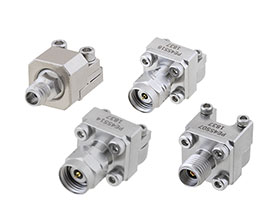

There has been an increasing use of RF coaxial connectors, especially microwave and millimetre-wave coaxial connectors, for high-speed digital and precision sensing applications, There is also a growing trend toward highly compact and interconnect-dense microwave and millimetre-wave systems, such as multi-input multi-output (MIMO) antennas for 5G and active electronically scanned array (AESA) radar antennas. These new systems tend to require coaxial connectors to provide interconnection between PCBs with minimal loss and mechanical ruggedness.
The complexity of these systems also requires equally complex testing. There are a variety of solderable coaxial interconnects for PCBs, as well as other interconnect strategies for PCBs, including custom RF connector harnesses and coaxial pogo-pins. However, these methods typically require a custom housing or substantial rework if the interconnect is only needed for testing. Moreover, having permanent interconnects on some PCBs may significantly increase the cost, weight, and size of a PCB.
In these cases, having removable end-launch coaxial connectors can be extremely advantageous. Given that these applications often need operating into the microwave and millimetre-wave frequency ranges, performance, reliability, and repeatability are all key considerations. Electrical performance factors, such as insertion loss and VSWR, are also critical. This is especially true for signal integrity, coplanar waveguide, microchip testing, SERDES, microwave substrate characterisation, test fixtures, and high-speed digital applications, such as 25 GbE.
End-launch coaxial connectors are generally frequency limited based on the type of coaxial connector used in the design. Hence, there are reusable end-launch connectors that offer broadband performance from DC to 110 GHz (1,0 mm coaxial connector), DC to 67 GHz (1,85 mm coaxial connector), DC to 50 GHz (2,4 mm coaxial connector), and DC to 40 GHz (2,92 mm coaxial connector).
The size of an end-launch connector is also dependent on frequency, hence the higher-frequency connectors are typically proportionally smaller than lower-frequency connectors. However, the higher-frequency connectors tend to offer lower power handling and greater insertion loss than the lower-frequency connectors.
Some of these reusable end-launch connectors allow for permanent soldering of the captive contact to the PCB if required, although they are designed to be attached and removed using a clamping mechanism with two screws with split-ring washers for a mechanically strong and reliable connection.
| Tel: | +27 21 555 8400 |
| Email: | [email protected] |
| www: | www.rfdesign.co.za |
| Articles: | More information and articles about RF Design |

© Technews Publishing (Pty) Ltd | All Rights Reserved